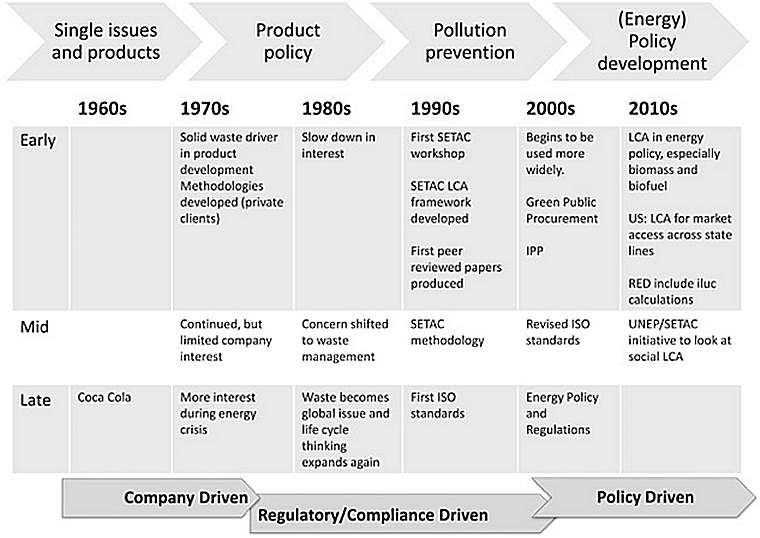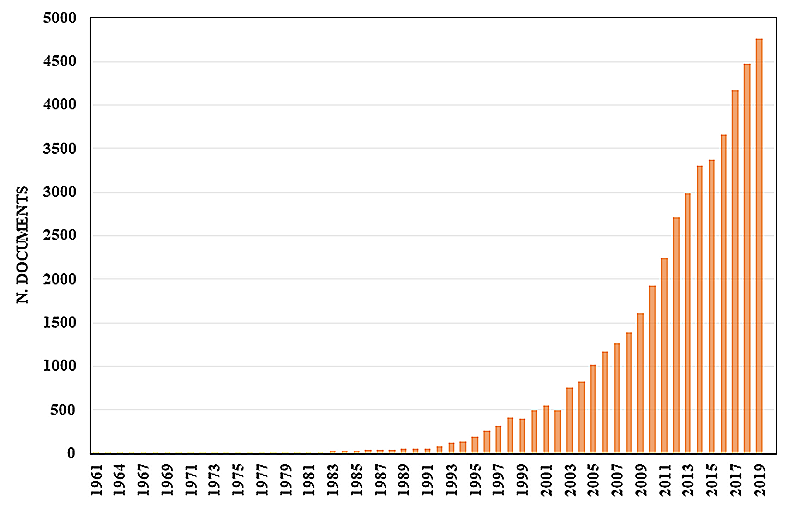The LCA methodology has evolved during the previous decades (since early 1960); indeed, the life-cycle-oriented methods mentioned before heralded the current LCA technique. In the beginning, these sorts of assessments were known as Resource and Environmental Profile Analysis (REPA) or Ecobalances, until the 1990s when the LCA term became the norm (Hunt, Sellers, and Franklin 1992). As it can be observed in Figure 4.1.1, early methods are characterized as material and energy accounting and were inspired by material flow accounting, as they are mainly focused on inventorying energy and resource use (e.g. crude oil, steel, etc.), emissions and generation of solid waste, from each industrial process in the life cycle of product systems. During some years, the emphasis of these assessments was on the generation of solid waste, which was considered problematic, mainly in the US, where landfilling was the dominant waste management practice. Similarly, at this stage, the methodology was initially employed to compare beverage packaging (McManus and Taylor 2015).

The second step of the evolution occurred when the analyses pass from a physical flow in a product life cycle (inventory results) to a potential environmental impact calculation. In brief, the list of resource used, and emissions are translated in a set of indicator scores for an assessed product, representing contributions to several impact categories, such as global warming, acidification, eutrophication, among others. Initial impact assessment methods are likely to represent impacts from emissions in the form of dilution volumes of air or water needed to dilute the emissions to safe levels or below regulatory thresholds, such as the Swiss Ecopoint method from the 1980s (Hauschild, M.Z., Rosenbaum, R.K. and Olsen 2018).
During the 1990s, the focus of the LCA was on pollution prevention Figure 4.1.1. In this regard, many impact assessment methods appeared, and the ambition was to quantify all relevant environmental impacts, independent of shifting public concerns, to avoid environmental burdens. The first impact assessment methodology that covers a wide-ranging set of midpoint impact categories was the CML92 (Heijungs et al., 1992)(Heijungs, R., Guinée, J.B., Huppes, G., Lankreijer, R.M., Udo de Haes, H.A., Wegener Sleeswijk, A., Ansems, A.M.M., Eggels, P.G., Duin, R.V. and De Goede 1992). Additionally, during the 1990s several life cycle inventory databases came out, covering various types of industrial sectors. In the same decade, due to the increasing demand of modeling complex product systems and the management of multiple life cycle databases and impact assessment methodologies, some software such as SimaPro® and GaBi were launched (GaBi 2020; Pré 2020).
In 1998, the ISO standards related to LCA published the ISO 14040: 1998 standard, which establishes the principles and structure of this methodology. In subsequent years, other ISO standards related to LCA appear, including ISO 14041: 1999 (objective, scope and inventory analysis), ISO 14042: 2001 (evaluation of the impact of the life cycle) and ISO 14043: 2001 (interpretation of life cycle impact). These standards have been reviewed and replaced by ISO 14040: 2006 (principles and frame of reference) and by ISO 14044: 2006 (requirements and guidelines) (International Organization for Standardization 14044 2007)(International Organization for Standardization 14044 2007). In a relatively short time, life cycle analysis has become an essential methodology for analyzing the sustainability of products and processes, as evidenced by the growing number of scientific articles. Figure 4.1.2 shows the evolution of publication in this field (around 45,656 documents, until 2019).
In the last two decades, the impact assessment methods have continuously been refined and several methodologies have emerged and are frequently being updated, including mid- and endpoints. As the methodology has been evolved with the new production industries around the world, such as bio-based products, assessment indicators like water and land use have appeared as relevant impact categories in the 2000s and 2010s. Currently, the application of hybrid LCA has emerged to gain benefits of process-based inventory analysis (Hauschild, M.Z., Rosenbaum, R.K. and Olsen 2018).
For additional information related to the past, present and future of the LCA methodology, read (more 4.1.1).







